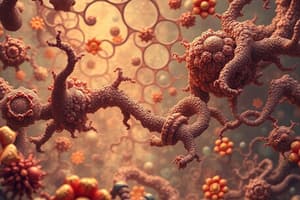Podcast
Questions and Answers
What is the effect of substrate concentration on enzyme activity up to a certain limit?
What is the effect of substrate concentration on enzyme activity up to a certain limit?
- Enzyme activity will fluctuate randomly with substrate concentration.
- Enzyme activity will decrease as substrate concentration increases.
- Enzyme activity will plateau after all active sites are occupied. (correct)
- Enzyme activity will consistently increase without limits.
What does denaturation of enzymes outside of the optimal pH range affect?
What does denaturation of enzymes outside of the optimal pH range affect?
- The substrate concentration needed for maximum activity.
- The temperature at which the enzyme can function.
- The physical shape of the substrate molecules.
- The enzyme's ability to catalyze reactions effectively. (correct)
How does increasing enzyme concentration affect the rate of reaction?
How does increasing enzyme concentration affect the rate of reaction?
- It results in a linear increase in the reaction rate. (correct)
- It leads to a decrease in the reaction rate due to overcrowding.
- It has no impact as enzymes remain inactive.
- It causes random fluctuations in reaction rates.
Why are enzymes typically present in low concentrations in living organisms?
Why are enzymes typically present in low concentrations in living organisms?
What happens to enzyme activity when substrate concentration saturates?
What happens to enzyme activity when substrate concentration saturates?
What role do enzymes play in chemical reactions?
What role do enzymes play in chemical reactions?
What term describes the specific region where a substrate binds to an enzyme?
What term describes the specific region where a substrate binds to an enzyme?
Which model describes an enzyme that conforms to fit its substrate more effectively?
Which model describes an enzyme that conforms to fit its substrate more effectively?
What is the effect of increasing molecular motion on enzyme reactions?
What is the effect of increasing molecular motion on enzyme reactions?
Enzymes that typically break down proteins are referred to as what?
Enzymes that typically break down proteins are referred to as what?
Which characteristic is true about the specificity of enzymes?
Which characteristic is true about the specificity of enzymes?
What happens to enzymes during the reactions they catalyze?
What happens to enzymes during the reactions they catalyze?
In what environment do enzyme reactions typically occur?
In what environment do enzyme reactions typically occur?
What type of reaction involves the combination of smaller compounds to form larger ones?
What type of reaction involves the combination of smaller compounds to form larger ones?
How does temperature affect enzyme activity?
How does temperature affect enzyme activity?
Which statement best describes catabolic reactions?
Which statement best describes catabolic reactions?
What is the role of the active site in an enzyme?
What is the role of the active site in an enzyme?
Which process describes the use of light energy to synthesize organic compounds from inorganic sources?
Which process describes the use of light energy to synthesize organic compounds from inorganic sources?
What is the effect of enzymes on activation energy?
What is the effect of enzymes on activation energy?
Which of the following can be a product of a catabolic reaction?
Which of the following can be a product of a catabolic reaction?
What type of reaction requires water as an input to break down larger compounds?
What type of reaction requires water as an input to break down larger compounds?
What is the effect of increased temperature on enzyme activity up to an optimal point?
What is the effect of increased temperature on enzyme activity up to an optimal point?
What happens to enzymes when they undergo denaturation?
What happens to enzymes when they undergo denaturation?
Which factor does NOT influence enzyme activity?
Which factor does NOT influence enzyme activity?
At what state is an enzyme most active?
At what state is an enzyme most active?
Which statement accurately describes the impact of pH on enzyme activity?
Which statement accurately describes the impact of pH on enzyme activity?
What role does thermal energy play in enzyme activity?
What role does thermal energy play in enzyme activity?
How does enzyme-substrate collision frequency affect enzymatic reactions?
How does enzyme-substrate collision frequency affect enzymatic reactions?
If an enzyme is fixed in a static position, what is likely to happen during catalysis?
If an enzyme is fixed in a static position, what is likely to happen during catalysis?
Flashcards
Metabolism
Metabolism
The chemical processes that occur within a cell to maintain life. These reactions provide energy and enable the synthesis and assimilation of cellular materials.
Enzymes
Enzymes
Biological catalysts that speed up chemical reactions without being consumed in the process.
Anabolism
Anabolism
Metabolic reactions that build larger molecules from smaller ones. These reactions usually require energy.
Catabolism
Catabolism
Signup and view all the flashcards
Condensation
Condensation
Signup and view all the flashcards
Hydrolysis
Hydrolysis
Signup and view all the flashcards
Active Site
Active Site
Signup and view all the flashcards
Enzyme Specificity
Enzyme Specificity
Signup and view all the flashcards
Aerobic Respiration
Aerobic Respiration
Signup and view all the flashcards
Photosynthesis
Photosynthesis
Signup and view all the flashcards
Induced Fit Model
Induced Fit Model
Signup and view all the flashcards
Brownian Motion
Brownian Motion
Signup and view all the flashcards
Substrate
Substrate
Signup and view all the flashcards
Denaturation
Denaturation
Signup and view all the flashcards
Activation Energy
Activation Energy
Signup and view all the flashcards
Rate of Reaction
Rate of Reaction
Signup and view all the flashcards
Optimal pH
Optimal pH
Signup and view all the flashcards
Optimal Temperature
Optimal Temperature
Signup and view all the flashcards
Thermal energy
Thermal energy
Signup and view all the flashcards
Enzyme pH Optimum
Enzyme pH Optimum
Signup and view all the flashcards
Substrate Saturation
Substrate Saturation
Signup and view all the flashcards
Enzyme Concentration and Reaction Rate
Enzyme Concentration and Reaction Rate
Signup and view all the flashcards
Enzyme Reusability
Enzyme Reusability
Signup and view all the flashcards
Enzyme Concentration in Living Organisms vs. Industry
Enzyme Concentration in Living Organisms vs. Industry
Signup and view all the flashcards
Study Notes
Enzymes
- Enzymes are globular proteins acting as biological catalysts
- They speed up reactions by lowering activation energy
- Enzymes aren't consumed in reactions, reusable
- Enzyme names typically end in "-ase" (e.g., lipase, protease)
- Substrates bind to the active site (a specific region on the enzyme)
- The lock-and-key model describes a rigid active site perfectly fitting the substrate
- The induced-fit model describes a flexible active site that changes shape to better accommodate the substrate
- Enzyme activity is influenced by temperature, pH, substrate concentration, and enzyme concentration
Metabolism
- Metabolism encompasses all chemical processes in a cell to sustain life
- Metabolic reactions can be anabolic (building larger molecules) or catabolic (breaking down larger molecules)
- Anabolism combines small molecules into larger ones, often through condensation reactions, releasing water
- Catabolism breaks down large molecules into smaller ones, usually requiring water (hydrolysis)
- Photosynthesis is an anabolic reaction, using energy from light
- Cellular respiration is a catabolic reaction, releasing energy from organic compounds
Factors Affecting Enzyme Activity
- Temperature: Optimal temperature leads to maximum activity, but high temperatures denature the enzyme, reducing activity
- pH: Enzymes have an optimal pH range; deviations affect enzyme structure and activity, leading to denaturation
- Substrate concentration: Increasing substrate concentration increases reaction rate until the enzyme is saturated, not further increasing rate
- Enzyme concentration: Increasing enzyme concentration linearly increases reaction rate up to saturation, at which point it's no longer limiting the reaction
Studying That Suits You
Use AI to generate personalized quizzes and flashcards to suit your learning preferences.




